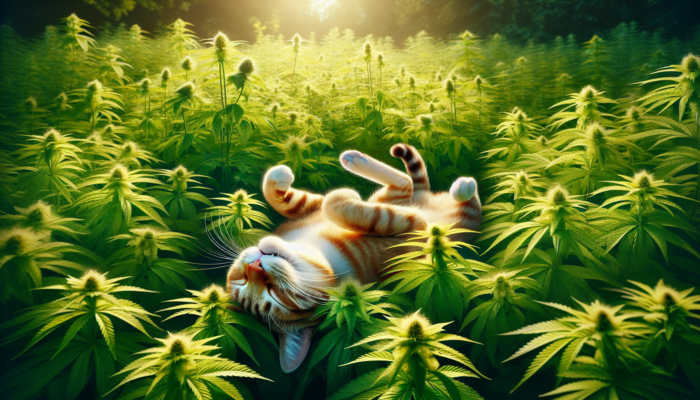Exploring the Captivating Connection Between Cats and Catnip: Insights into Feline Behavior
Catnip, scientifically recognized as Nepeta cataria, is an intriguing herb that creates a one-of-a-kind relationship with our cherished cats. This member of the mint family has enchanted cat lovers and veterinary experts for countless generations. What exactly about this unassuming plant causes such remarkable responses in our feline friends? To truly grasp this captivating phenomenon, we need to uncover the scientific principles that explain cats’ fascination with catnip, investigating the complex biochemical processes that trigger these extraordinary behaviors.
Diving into the Biochemical Mechanisms Behind Feline Reactions to Catnip

The core of a cat’s compelling attraction to catnip lies in a powerful compound known as nepetalactone. This aromatic oil, primarily concentrated in the leaves and stems of the plant, directly interacts with a cat’s olfactory receptors, sparking a delightful array of behaviors that range from playful antics to peaceful relaxation. When exposed to catnip, cats may engage in a variety of actions, including rolling, rubbing, and purring, or may experience brief bursts of excitement. These behaviors are not mere coincidence; they are deeply rooted in evolutionary instincts that reflect a cat’s inherent hunting tendencies.
Interestingly, a cat's reaction to catnip is significantly influenced by its genetic background. Studies indicate that approximately 50-75% of the feline population displays a behavioral response to nepetalactone, while others may remain indifferent. This hereditary trait emphasizes a crucial connection between a cat’s ancestry and its sensitivity to this captivating herb. Kittens and older cats often demonstrate a diminished sensitivity, as the ability to react typically develops around six months of age, coinciding with their sexual maturity.
Moreover, the effects of catnip can vary widely among individual cats. While some may showcase bursts of energy, racing gleefully around the room, others might prefer to unwind and relish in the calming effects of the herb. Factors such as the cat’s mood, environmental context, and prior experiences with catnip can greatly influence these responses. Understanding these nuances deepens our insight into the relationship between cats and catnip and underscores the complex interplay between a cat’s biological makeup and its behavior.
Unraveling the Variety of Catnip Responses: A Look into Unique Feline Behaviors
The diverse array of reactions to catnip provides a fascinating glimpse into feline behavior. As mentioned previously, genetic factors play a pivotal role in determining whether a cat will respond positively to catnip. Cats that inherit sensitivity to nepetalactone often display a wide range of behaviors, from spirited frolics to profound calmness. Notably, the intensity and duration of these reactions can vary significantly among different cats.
For instance, one cat might joyfully leap through the air, rolling and tumbling across the floor, while another may merely sniff the herb with little enthusiasm. Additionally, a cat’s response can evolve over time; a feline that previously ignored catnip might develop a newfound affection for it as it matures or as its environment changes. The method of exposure is also crucial; fresh catnip typically incites stronger reactions compared to dried varieties, which may lose their potency over time.
Environmental influences are equally vital. A cat’s reaction to catnip can be amplified in an enriched environment filled with stimulating toys and avenues for exploration. Conversely, a cat that feels stressed or anxious may not respond as eagerly, highlighting the importance of providing a nurturing and engaging home setting to foster optimal feline happiness.
Recognizing these subtleties underscores the necessity for cat owners to closely observe their pets and tailor the introduction of catnip to their unique preferences. Whether through toys, sprays, or fresh leaves, the presentation method should be customized to suit each cat’s distinct personality and desires.
Boosting Your Cat’s Happiness with Catnip: The Role of Enrichment in Feline Lives
Incorporating catnip into a cat’s daily routine goes beyond mere amusement; it plays a vital role in enhancing feline enrichment. Enrichment is crucial for maintaining a cat’s mental and physical health, and catnip can significantly contribute to this goal. By promoting natural behaviors, catnip helps prevent boredom and encourages physical activity, which is especially important for indoor cats.
When utilized wisely, catnip can transform playtime into an engaging experience that encourages exercise and overall well-being. By providing cats with catnip-infused toys, owners can motivate them to jump, chase, and pounce, mimicking the hunting behaviors they would typically exhibit in the wild. This not only keeps them physically active but also stimulates their cognitive functions, as they strategize during play.
Furthermore, the soothing properties of catnip can be advantageous in alleviating stress and anxiety. For cats that may be timid or easily startled, introducing catnip can foster a calming atmosphere, enabling them to feel more secure and comfortable in their surroundings. This can be particularly beneficial during stressful situations, such as moving to a new home or welcoming a new pet.
Ultimately, the intricate connection between cats and catnip enhances our understanding of feline behavior and overall wellness. By recognizing the scientific foundation behind catnip’s allure and the variability in its effects among different cats, we can capitalize on its benefits to enrich our pets’ lives. Whether through stimulating play or soothing relaxation, catnip plays a cherished role in the lives of both cats and their owners, highlighting its significance as a beloved herb in the feline world.
Tracing the Historical Journey of Catnip: Uncovering Its Cultural Significance

Examining the history of catnip unveils how this remarkable herb has journeyed through time and various cultures, becoming an essential element of both feline care and traditional medicinal practices. From its ancient origins to its contemporary appeal, catnip has intricately woven itself into the fabric of human and feline relationships.
Exploring Ancient Uses of Catnip: Medicinal and Recreational Aspects
Catnip possesses a rich heritage that spans millennia. Originating in Europe and Asia, it was embraced by numerous civilizations for its medicinal properties long before it captured the attention of cats. The ancient Greeks and Romans recognized the herb’s potential, frequently using it to alleviate ailments such as digestive troubles and sleep disturbances. The calming effects of catnip were documented by notable historical figures, including the Roman scholar Pliny the Elder, who extolled its soothing benefits.
In addition to its medicinal uses, catnip has also served as a recreational herb. In ancient times, it was believed that people brewed catnip into teas to enjoy its gentle sedative effects. This dual purpose—serving both humans and felines—highlights the unique bond between cats and this herb throughout history.
As the centuries progressed, catnip became deeply entrenched in various folk traditions, with different cultures around the world embracing its versatility. In some societies, it was believed to possess protective qualities, warding off evil spirits and promoting tranquility. This rich tapestry of historical applications underscores catnip’s significance, extending beyond mere entertainment for pets; it has long been esteemed as a valuable herb in the realm of natural healing.
The Revival of Catnip’s Popularity in Modern Society: A Trend Among Cat Lovers
In contemporary times, catnip has witnessed a remarkable resurgence, becoming a favored choice among cat owners globally. This revival can be attributed to an increased awareness of the importance of enriching a cat’s environment. As pet owners search for ways to enhance their cats’ well-being, catnip has emerged as a popular solution for stimulating play and providing relaxation.
The rise of the internet and social media has significantly contributed to catnip’s renewed popularity. Viral videos showcasing cats in euphoric states of play have captivated audiences, inspiring many to explore the herb for their pets. This exposure has encouraged a wider understanding of the herb’s effects and benefits, motivating cat owners to incorporate it into their cats’ daily routines.
Moreover, the pet care industry has responded to this growing demand by offering a diverse range of catnip-infused products, including toys and sprays. These innovations have simplified the process for cat owners, making it easier than ever to introduce catnip into their pets’ lives while catering to the varying preferences of different felines. Consequently, the modern landscape of pet care has embraced catnip, cementing its status as a crucial element of feline enrichment.
Understanding the Cultivation and Distribution of Catnip: From Farm to Pet

Gaining insight into the origins of catnip also involves understanding its cultivation and distribution. Catnip is relatively easy to cultivate, thriving in well-drained soil with minimal care. Its popularity has led to an increase in commercial farming, with large-scale operations dedicated to producing high-quality catnip for the pet industry.
Primarily grown in the United States and Canada, catnip is harvested during the summer months when its essential oils are at their peak concentration. After harvest, the leaves and flowers are dried and prepared for various products, including catnip toys and herbal mixtures. This process is crucial for ensuring that catnip retains its potency and appeal, delivering the desired effects to our feline friends.
In addition to commercial sources, many cat owners prefer to grow their catnip at home. Cultivating catnip not only provides a fresh supply but also offers a rewarding gardening experience. Homegrown catnip can be harvested and utilized in various forms, from fresh leaves to DIY catnip toys, fostering a deeper connection between cats and their owners.
Overall, the journey of catnip from ancient times to the present encapsulates its enduring significance in both feline and human cultures. As we continue to explore the multifaceted relationship between cats and catnip, we gain a richer appreciation for this remarkable herb and its role in enhancing the lives of our beloved pets.
Maximizing the Benefits of Catnip: Practical Strategies for Enriching Your Cat’s Life
The practical applications of catnip extend beyond mere amusement; they encompass a myriad of benefits that enhance the quality of life for both cats and their owners. Understanding how to effectively utilize catnip can lead to a more harmonious and enriching environment for our feline companions.
Encouraging Play and Exercise with Catnip: A Gateway to Feline Wellness
Encouraging play and exercise in cats is essential for their physical and mental health. Catnip serves as an excellent catalyst for motivating our feline friends to engage in active play. By incorporating catnip into toys, cat owners can stimulate their cats’ natural hunting instincts, promoting exercise that is vital for maintaining a healthy weight and preventing obesity.
Catnip-filled toys can captivate even the most lethargic cats, igniting their interest and prompting them to chase, pounce, and explore. The allure of catnip transforms routine playtime into an exhilarating experience, providing cats with the physical activity they require while satisfying their innate curiosity.
Moreover, integrating catnip into interactive play sessions can strengthen the bond between cats and their owners. As cats engage in spirited play, they release pent-up energy, leading to a happier and more balanced temperament. Regular playtime enriched with catnip not only benefits the cat’s physical health but also fortifies the connection between pet and owner, creating cherished moments that both parties value.
Utilizing Catnip as a Positive Training Tool: Enhancing Behavioral Reinforcement Techniques
In addition to promoting play, catnip can function as an effective training aid, employing positive reinforcement strategies to encourage desirable behaviors. For example, cat owners can reward their cats with catnip when they exhibit actions such as using a scratching post or following commands. This association between the desired behavior and the enjoyable effects of catnip creates a strong motivation for cats to repeat those actions.
Training with catnip can also alleviate stress during significant life transitions, such as moving or introducing a new pet. By providing catnip during these changes, owners can establish positive associations, helping their cats adjust more comfortably to new circumstances.
Furthermore, incorporating catnip into a reward system can transform training sessions into enjoyable experiences for both cats and their owners. The engaging nature of catnip can elevate routine training exercises into fun bonding moments, reinforcing the connection between them and making the learning process more effective.
Exploring the Calming Effects of Catnip: Easing Stress and Anxiety in Cats
Beyond its playful attributes, catnip possesses therapeutic effects that can assist in managing stress and anxiety in cats. Many felines experience anxiety in various situations, such as thunderstorms, fireworks, or visits to the veterinarian. The calming properties of catnip can help alleviate these feelings, providing a natural solution for stress-induced behaviors.
When introduced in a safe and controlled manner, catnip can encourage relaxation. Owners may consider offering catnip before stressful events or as part of a calming routine. This practice can help cats feel more at ease, reducing the likelihood of stress-related behaviors such as hiding or excessive vocalization.
Moreover, incorporating catnip into a cat’s environment can enhance their overall well-being. By creating a tranquil space infused with the soothing aroma of catnip, owners can cultivate a calming atmosphere that encourages relaxation. This proactive approach can lead to a more balanced and content feline, ultimately improving their quality of life.
As we delve into the realm of cats and catnip, it becomes clear that this herb serves not only as a source of entertainment but also as a valuable resource for enhancing feline health and happiness. By understanding its practical applications, cat owners can harness the power of catnip to create a joyful and enriched environment for their beloved companions.
Discovering Alternatives to Catnip: Exploring Other Feline-Friendly Herbs
While catnip holds a special place in the hearts of many cats, there are several other herbs that can provide similar or even enhanced experiences. Familiarizing yourself with these alternatives expands the options available to cat owners seeking to further enrich their pets’ lives.
Introducing Silver Vine: A Potent Alternative to Catnip
Silver vine, scientifically referred to as Actinidia polygama, is often celebrated as a powerful substitute for catnip. Native to the mountainous regions of Asia, particularly Japan and China, silver vine has gained popularity for its ability to elicit strong responses in cats that may show indifference to catnip. The active compounds in silver vine, including actinidine, have been shown to stimulate cats in ways that catnip may not, making it an excellent choice for those with less responsive felines.
When introduced to cats, silver vine can provoke behaviors similar to those observed with catnip—rolling, rubbing, and playful antics. Interestingly, research indicates that a greater percentage of cats respond positively to silver vine compared to catnip, making it an appealing alternative for cat owners looking to engage their pets or stimulate play.
Silver vine can be offered in various forms, including powder, sticks, or as an infusion in toys. Its unique effects and broader appeal make it a valuable addition to the array of cat-friendly herbs, providing an alternative for cats who do not engage with catnip.
Exploring Valerian Root and Tatarian Honeysuckle: Unique Options for Feline Stimulation
Beyond silver vine, two other herbs—valerian root and Tatarian honeysuckle—offer intriguing alternatives for stimulating feline curiosity and playfulness. Valerian root, derived from the Valeriana officinalis plant, is renowned for its calming properties in humans but can elicit the opposite effect in cats. When exposed to valerian, many cats exhibit playful and euphoric responses, similar to those experienced with catnip and silver vine.
On the other hand, Tatarian honeysuckle, or Lonicera tatarica, is less commonly known but equally compelling. The wood of the Tatarian honeysuckle plant can spark excitement in some cats, particularly those who may not respond to catnip. This herb can be utilized in various forms, such as wood blocks or infused products, providing an alternative source of engagement for felines.
Both valerian root and Tatarian honeysuckle can be introduced in various ways, from toys to herbal blends, allowing for flexibility in how cat owners choose to enrich their pets’ experiences. As we continue to explore cats and catnip, these lesser-known options highlight the diversity of herbs available for feline enrichment.
Understanding Individual Preferences: Selecting the Best Herb for Your Cat
When considering alternatives to catnip, understanding your cat’s individual preferences and responses is crucial. Each cat has unique tastes and sensitivities, meaning that experimentation may be necessary to determine which herb resonates most with them.
For example, if your cat has shown little interest in catnip, introducing silver vine or valerian root may reveal a newfound enthusiasm for play. Observing your cat’s reactions will provide valuable insights into their preferences, guiding you in selecting the most suitable herb.
Moreover, combining various herbs can offer enhanced stimulation and engagement. Some cat owners may opt to rotate different options, ensuring that their cats remain intrigued and entertained. This approach not only enriches their environment but also caters to the inherent curiosity that characterizes feline behavior.
In summary, exploring alternatives to cats and catnip opens up a wealth of possibilities for enhancing our feline companions’ lives. By testing and observing their responses to different herbs, cat owners can create a dynamic and engaging play environment that caters to their pets’ unique preferences.
Ensuring Safe Use of Catnip: Guidelines for Responsible Cat Care
As with any aspect of pet care, understanding the safety and appropriate dosage of catnip is crucial for ensuring our feline friends’ well-being. Although catnip is generally safe for cats, responsible usage is vital to maximizing its benefits while minimizing potential risks.
Establishing Safe Dosages of Catnip: Finding the Right Balance
Determining the right amount of catnip is essential for providing a balanced experience for your cat. Generally, moderation is key; small amounts of catnip can be beneficial, while excessive exposure may lead to diminished effects or unwanted behaviors.
For most cats, a light sprinkle of dried catnip or a few catnip-filled toys is sufficient to elicit a response. Owners should closely monitor their cats’ reactions and adjust the amount as necessary. If a cat appears overly stimulated or agitated, it may indicate that they have had too much.
It is also important to consider the frequency of catnip exposure. Limiting sessions to a few times per week allows your cat to fully process the experience before reintroducing catnip. This strategy prevents the herb from losing its allure and ensures that each interaction remains engaging and fresh.
Recognizing Possible Side Effects: Staying Attentive to Your Cat’s Reactions
While catnip is safe for most felines, some individuals may experience mild side effects. These can include gastrointestinal upset or excessive excitement, potentially leading to aggressive play behaviors. In rare cases, a cat may develop an aversion to catnip following repeated overexposure, indicating that they need a break from the herb.
Responsible cat ownership involves closely observing your pet’s responses. If any adverse effects arise, such as vomiting, lethargy, or unusual behavior, it is advisable to discontinue the use of catnip and consult with a veterinarian. This precaution ensures the safety and well-being of your feline friend while navigating the world of cats and catnip.
Introducing Catnip to Kittens: Best Practices for a Positive Experience
When introducing catnip to kittens, a thoughtful approach is essential. As previously mentioned, kittens typically lack sensitivity to catnip until they reach around six months of age. Thus, it is crucial to wait until your kitten matures before introducing this herb.
When the time is right, start with small amounts of catnip to gauge your kitten’s reactions. Observing their interactions is vital; some may respond enthusiastically, while others may remain indifferent. If your kitten shows a positive response, gradually increase exposure through toys or by sprinkling catnip on scratching posts.
Always ensure that the introduction of catnip is a fun and positive experience. This approach can foster a love for the herb and help associate playtime with joy. As your kitten grows and develops its personality, you will refine your understanding of its preferences, paving the way for a fulfilling and enriched life.
In summary, understanding the safety and dosage guidelines surrounding cats and catnip</b














